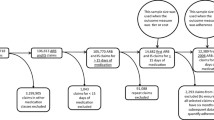Abstract
BACKGROUND
Electronic prescribing (e-prescribing) has the potential to improve the safety and efficiency of medication use, but uptake of e-prescribing in community-based settings has been limited to date. In April 2004, 2 large insurers in Massachusetts began a program to fund e-prescribing systems for targeted clinicians and practices. We studied the adoption and uptake of e-prescribing by the targeted prescribers.
METHODS
We obtained data on all e-prescriptions written from April 2004 to March 2005. We tabulated the number of clinicians using the e-prescribing system and the number of prescriptions written. We also obtained claims data from the 2 insurance companies and calculated the proportion of each clinician’s prescriptions that were written electronically. We developed multivariable models to estimate the impact of different clinician characteristics on the proportional rate of e-prescribing.
RESULTS
During the first 12 months of the e-prescribing program, 1,217 prescribers began using the e-prescribing system. In the final month of the study, over 55,000 e-prescriptions were written for patients covered by the 2 included insurance plans. The proportion of total reimbursed claims per clinician written electronically increased slowly during the study period and was still below 30% by the end of the study period. This number increased to 42% when we restricted the sample to medications normally used for acute indications. Multivariable models showed that younger clinicians, pediatricians, and prescribers in larger practices exhibited higher uptake rates as a proportion of total prescriptions.
CONCLUSIONS
Clinician use of e-prescribing increased steadily in the first 12 months of an initiative sponsoring e-prescribing systems. Uptake of e-prescribing was only partial, with younger clinicians and pediatricians more likely to use the system. Research to understand why prescribers vary in their use of e-prescribing and to develop techniques to encourage more wide-spread adoption will be an important priority for future studies.



Similar content being viewed by others
References
Bates DW, Leape LL, Cullen DJ, et al. Effect of computerized physician order entry and a team intervention on prevention of serious medication errors. JAMA. 1998;280:1311–6.
Bates DW, Teich JM, Lee J, et al. The impact of computerized physician order entry on medication error prevention. J Am Med Inform Assoc. 1999;6:313–21.
Evans RS, Pestotnik SL, Classen DC, et al. A computer-assisted management program for antibiotics and other antiinfective agents. N Engl J Med. 1998;338(4):232–8.
Raschke RA, Gollihare B, Wunderlich TA, et al. A computer alert system to prevent injury from adverse drug events: development and evaluation in a community teaching hospital. JAMA. 1998;280:1317–20.
Peterson JF, Kuperman GJ, Shek C, Patel M, Avorn J, Bates DW. Guided prescription of psychotropic medications for geriatric inpatients. Arch of Intern Med. 2005;165:802–7.
Fischer MA, Lilly CM, Churchill WW, Baden LR, Avorn J. An algorithmic computerised order entry approach to assist in the prescribing of new therapeutic agents: case study of activated protein C at an academic medical centre. Drug Safety. 2004;27:1253–61.
Fischer MA, Solomon DH, Teich JM, Avorn J. Conversion from intravenous to oral medications: assessment of a computerized intervention for hospitalized patients. Arch Intern Med. 2003;163:2585–9.
Chaudhry B, Wang J, Wu S, et al. Systematic review: impact of health information technology on quality, efficiency, and costs of medical care. Ann Int Med. 2006;144:742–52.
Bell DS, Marken RS, Meili RC, et al. Recommendations for comparing electronic prescribing systems: results of an expert consensus process. Health Aff 2004;Suppl Web Exclusives:W4-305-17.
Hammond WE. Perspective: the role of standards in electronic prescribing. Health Aff 2004;Suppl Web Exclusives:W4-325-7.
Elson B. Electronic prescribing in ambulatory care: a market primer and implications for managed care pharmacy. J Manag Care Pharm. 2001;7:115–20.
Miller RA, Gardner RM, Johnson KB, Hripcsak G. Clinical decision support and electronic prescribing systems: a time for responsible thought and action. J Am Med Inform Assoc. 2005;12:403–9.
Overhage JM, Perkins S, Tierney WM, McDonald CJ. Controlled trial of direct physician order entry. J Am Med Inform Assoc. 2001;8:361–71.
Grossman JM, Gerland A, Reed MC, Fahlman C. Physicians’ experiences using commercial e-prescribing systems. Health Aff. 2007;26:w393–w404.
Fox G, Weidmann E, Diamond D, Korbey A. Hand-held electronic prescribing. J Fam Pract. 2001;50:449–54.
Hagland M. Tech trends. Healthcare Inform. 2006;23:38–40.
Halamka J, Aranow M, Ascenzo C, et al. E-prescribing collaboration in Massachusetts: early experiences from regional prescribing projects. J Am Med Inform Assoc. 2006;13:239–44.
Center for Information Technology Leadership. The value of computerized order entry in ambulatory settings; 2003.
Blumenthal D, Weissman JS, Wachterman M, et al. The who, what, and why of risk adjustment: a technology on the cusp of adoption. J Health Polit Policy Law. 2005;30:453–73.
Rogers E. Diffusion of innovations, 5th ed. New York: Free Press; 2003.
Harvey KJ, Vitry AI, Roughead E, Aroni R, Ballenden N, Faggotter R. Pharmaceutical advertisements in prescribing software: an analysis. Med J Aust 2005;183:75–9.
Acknowledgment
We gratefully acknowledge the assistance of BCBSMA, Tufts HP, and ZixCorp in providing data for this research. The investigators retained control over all aspects of the analyses and presentation of results. This research was supported by AHRQ grant R01 HS15175.
Conflict of Interest Statement
None disclosed.
Author information
Authors and Affiliations
Corresponding author
Rights and permissions
About this article
Cite this article
Fischer, M.A., Vogeli, C., Stedman, M.R. et al. Uptake of Electronic Prescribing in Community-Based Practices. J GEN INTERN MED 23, 358–363 (2008). https://doi.org/10.1007/s11606-007-0383-1
Published:
Issue Date:
DOI: https://doi.org/10.1007/s11606-007-0383-1




